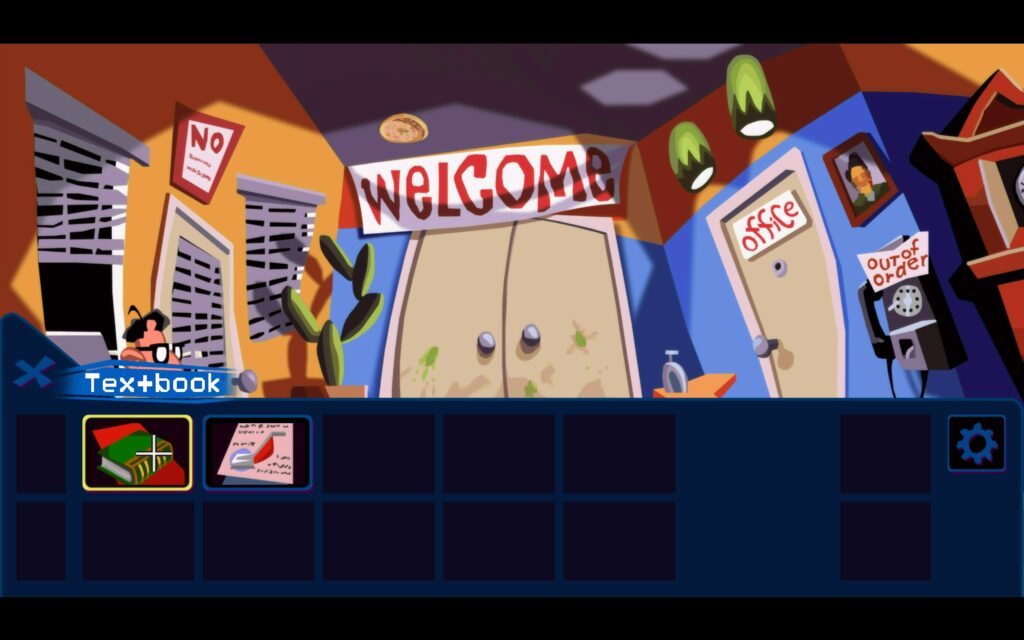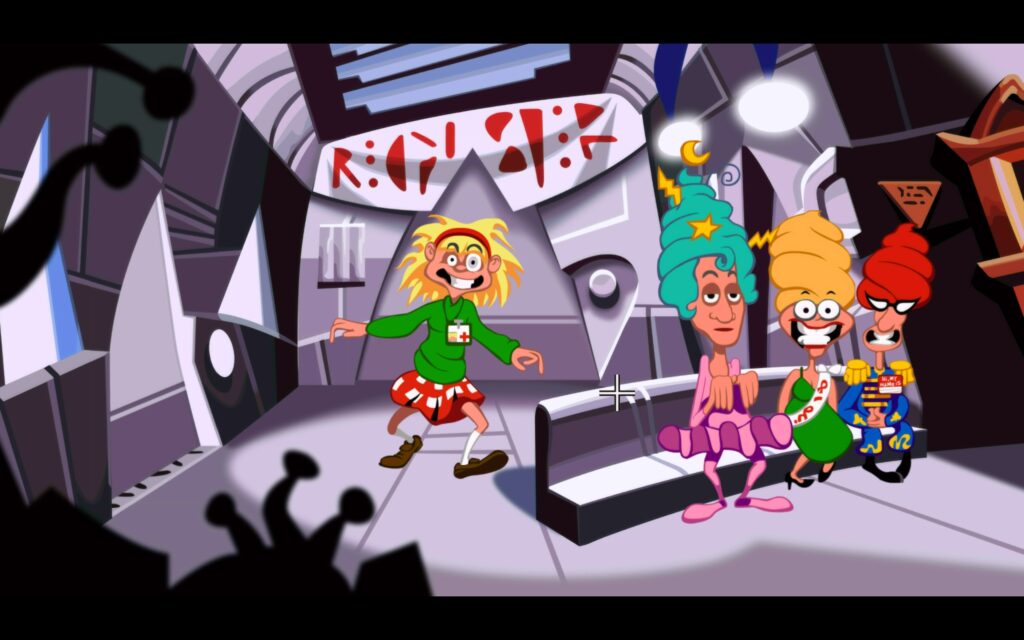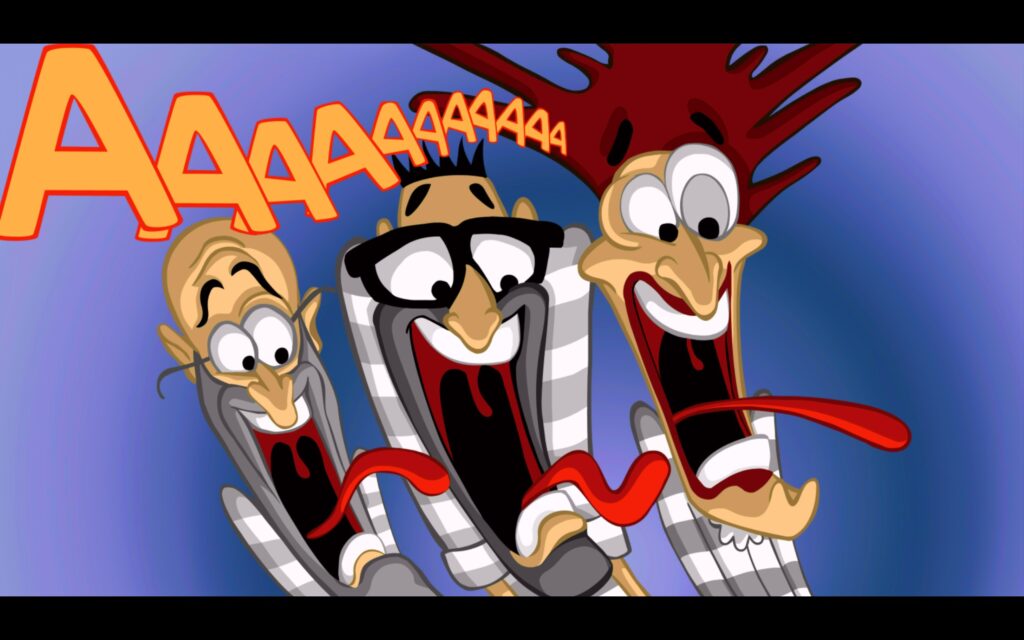One of the most beloved classic adventure games of the ’90s, Day of the Tentacle, returns in a beautifully remastered version that breathes new life into a quirky, time-traveling tale. The remastered version adds updated graphics, remastered audio, music, and sound effects, as well as an improved UI to make it more accessible to today’s players.
Legacy of Maniac Mansion
The Day of the Tentacle was originally released as Maniac Mansion II: Day of the Tentacle in 1993. It was a sequel to the 1987 game Maniac Mansion, and the eighth LucasArts game to use the SCUMM engine. This game marked the first time Dave Grossman and Tim Schafer led the development of a game. Both had previously worked together on Secret of Monkey Island and its sequel, and they would go on to work on games like Grim Fandango and Psychonauts.

The story and style of the game were inspired, among other things, Chuck Jones cartoons and American History. This was reflected in many positive reviews of the game, praising its humour and style, many relating the game to Looney Tunes shorts. Despite only achieving moderate sales, it is still regularly featured in many top games lists. It is perhaps being well remembered that led to DoubleFine games creating a remastered version of the game.
Story
When we start the game, we see a purple tentacle eats toxic waste, in spite of its green friend’s protests. This causes it to mutate and grow arms, become evil in the process. The tentacle sets out to take over the world (of course!).

Our protagonists are Bernard, a not-so-socially-awkward nerd who takes the lead; Laverne, an eccentric medical student; and Hoagie, a fazed out rock band roadie who’s just along for the ride. When they get the call from the green tentacle, purple tentacle’s friend, they rush to the mad scientist’s mansion to help. Edison, the resident scientist, attempts to send the characters back in time one day so they can fix things, but ends up sending Hoagie 200 years into the past and Laverne 200 years into the future instead.

Now, 200 years apart from each other, they have to work together so they can prevent the evil tentacles from taking over the world. And they need to do it yesterday.
Setting
The entire game takes place in a single mansion, the Edison Mansion, at three points in history. In the modern day it is the time our characters are from, some time in the early 90s. It is a little fantastical with a mad scientist that creates zany devices, such as a hamster power generator, time machines, and sentient disembodied tentacles.

The past happens to be around the time that the Declaration of Independence was drafted, and the Edison Mansion happens to be where John Hancock, Thomas Jefferson, and George Washington are having a meeting. Benjamin Franklin is also designing a kite here. The historical references aren’t meant to be accurate, rather they are being used as fun plot devices, and even reference historical fiction as much as historical fact.

In the future, the tentacles have taken over. The mansion has been remade out of metal, and humans are kept as pets by the tentacles. Laverne has to navigate her way around their bureaucracy and tentacle guards in order to survive the perils of a world ruled by sentient tentacles with fingerless hands.
Script
The dialogue has a very tongue-in-cheek tone, aiming for comedy over realism. It made me think of early Scooby Doo, or Looney Tunes shorts – light-hearted humour for kids that adults can enjoy. It’s comedy that still stands the test of time, and there were a couple of moments I laughed out loud as I was playing through the game.

The humour may not be for everyone. This isn’t a laugh-out-loud comedy, more of a “let’s have fun with a story”. Some of the jokes may seem childish to older players, or may not tickle the same nostalgia that it did when I played the game.

Still, many dialogue options prove important, revealing clues and information that help you progress. If you had never heard of the Cherry Tree Myth, as I hadn’t, then the game makes sure you can still make the connection through dialogue that appears to be another joke at first. The script is littered with gems like this, that at first seem unimportant, but make a light bulb appear at some point later in the game.
Problem Solving
Like other early LucasArt games, talking to people and figuring out where/when to use items is the main gameplay loop. The twist is the time travel. This adds an extra element to solving each puzzle that involves thinking about the past and the future.

As an example, Laverne starts out trapped in a kumquat tree in the future. She can’t do anything, so you cannot select her as a character at first. Bernard and Hoagie can both be selected. Hoagie happens to be in the mansion where George Washington resides in the past. At some point he will find some red paint. On learning that Washington has a tendency to cut down cherry trees, you can logically work out a solution.

Hoagie needs to paint the kumquats red, convincing Washington that the tree is a cherry tree. Then he can convince him to cut it down. Now that the tree is cut down in the past, it no longer exists 400 years in the future, so Laverne is no longer trapped in a tree. She then becomes a playable character from that point onward.

There are several puzzles like this, where you have to send items back and forth through time. The time machines themselves can be used to transport items instantly, but sometimes you need to find a way to change an item over time. A particularly clever puzzle involves leaving an item somewhere in the past to age, so that Laverne can then send the aged item back to the past.

Most of the puzzles were solvable through sheer logic. Even when I had to look up a solution I would realise how I was supposed to have figured out the solution. However, there were a couple of times where I was completely stumped, and even after resorting to a guide I had no idea how you were supposed to figure it out.

Overall it’s still well put together. As far as I could tell there are no ways to soft lock yourself, or to lose the game. You can just keep playing and eventually you will figure out the next step, or spot something you’ve missed. The game’s time-travel puzzles especially encourage players to think outside of the typical item-based puzzle-solving box, creating solutions that feel genuinely rewarding when the pieces come together.
Remaster
The remaster changes almost every aspect of the game, while still maintaining its original charm. The graphics and audio have been updated, with beautifully drawn hi-resolution artwork that stays true to the original concept. The animation matches the comedic tone of the game, with larger than life characters that seem plucked right out of a Hanna-Barbera cartoon, and exaggerated movements and actions that would fit any Warner Brothers animation. The backgrounds are cartoonish, almost Tim Burton-esque with less of a gothic tone. The visuals mesh perfectly with the game’s offbeat humor, enhancing the sense that you’re playing through a cartoon rather than a conventional video game.

The UI also has some updates over the original. In the original game, you had to click the action you wanted to use, then click the thing you wanted to do the action on. So to “Push” a speaker, you’d first have to click “push”, then click on the speaker. At the time of release the game’s interface was praised, but the remaster improves it further.

Now there is a radial menu that appears when you right-click an item of interest. You can then select the action from the radial menu, be it “push”, “pull”, “open”, or “use”. The result is the same, but it’s a much cleaner interface, that allows the game itself to use the whole screen to render its environment.

The remaster also adds the ability to highlight items that can be interacted with using the Shift key. This saves players from having to search the screen with their mouse to find all the things they can interact with, and makes it harder to miss key objects as you explore the mansion.

Some purists may not like the ease of the new radial menu and ability to highlight areas of interest. Thankfully, you can press F1 to switch the graphics, audio, and even the interface back to the way it was in 1993. This mode removes the radial menu and the highlight feature, turning the game into an emulation. I used this several times to compare the old game to the remaster and, in my opinion, the updated graphics and audio have remained faithful to the original design.

These UI enhancements make the game more accessible to modern audiences. Some people may be put off by poorer graphics and slightly convoluted interfaces (by today’s standards), so wouldn’t get into the game in its original form. So it lowers the barrier of entry for newer players who are more used to modern games, without sacrificing the original vision for the game.

The remastered version also adds a developer’s commentary, as well as some of the original concept art, so you can truly learn about the roots of this game and where it came from. Playing through the game again with the commentary on is especially fun, as you can learn a lot of interesting stories behind the game’s development. For example, the entire introductory sequence with the car, the part that sets the tone for the whole game, was actually animated by an intern. Hearing about the struggles, arguments, and creativity that went into different sections of the game gives you a new appreciation for the thought that went into the game’s design and development.
Complete It
After playing through the game, I can definitely say it was a fun experience. Every element works together well, and the last joke is probably the funniest in the entire game. The Steam version of the game has several achievements that are still unlocked, all of them secret. I’m not enough of a completionist to chase all of them down, but I am playing through the game again with the commentary on, so maybe I’ll pick up a few more along the way.

With its clever puzzles, and timeless humor, Day of the Tentacle remains a must-play for both newcomers and longtime fans of point-and-click adventure games.





One thought on “Day of the Tentacle Remastered”
Comments are closed.